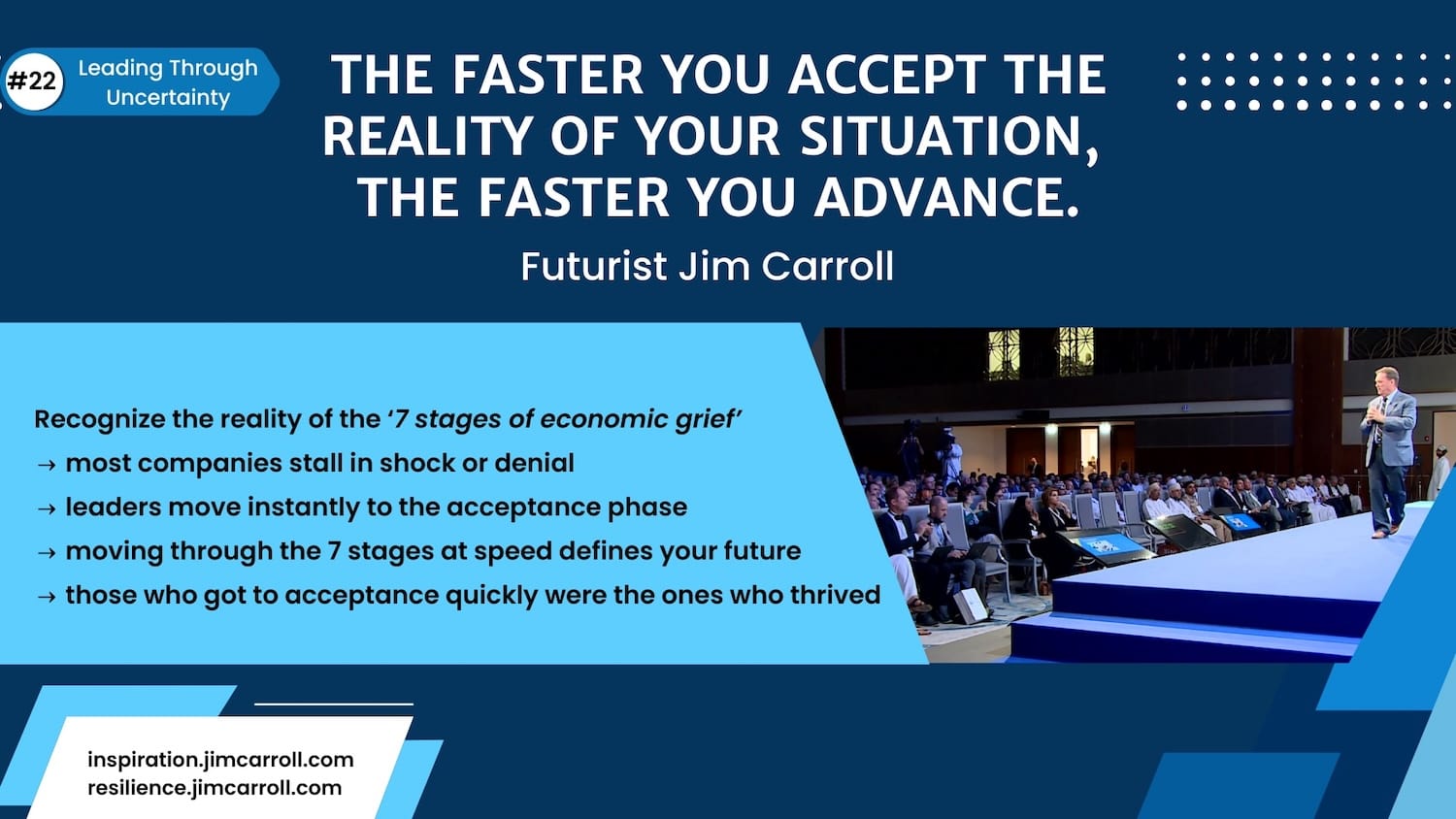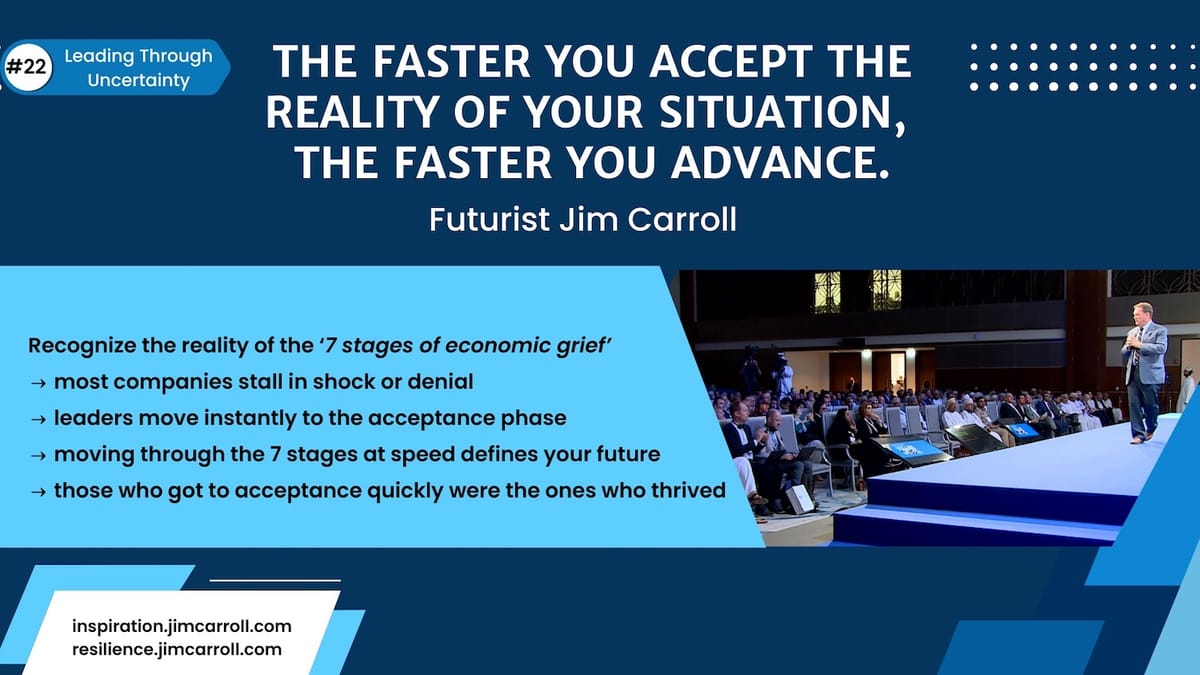"The faster you accept the reality of your situation, the faster you advance" - Futurist Jim Carroll

(Note: Today's post is #22 in the series, but will actually be chapter 2 in the forthcoming book! When I started writing this series over a month ago, I never had plans other than to write a series - perhaps 10 posts on the theme of ‘leading in uncertainty.’ I then realized it would become 15 posts. Before I knew it, 20! I now see light at the end of the tunnel! The next few posts – to come Wednesday and Thursday and Friday – will actually become Chapters 1 and 2 and 3 in the Dancing in the Rain book. After that, post #25 will be the wrap-up and the closing chapter! At the same time that I’ve been writing these posts, I’ve been feeding them into my word processing software to get them into actual book format. The future happens fast!
Progress in a time on uncertainty begins the moment you stop waiting for the old world to return, and start preparing for the next one.
This is where the idea of the '7 Stages of Economic Grief' comes in. Much like the stages of personal grief, organizations often move through a predictable cycle during economic downturns. Understanding these stages, and accelerating through them, is key to resilience.
- Shock: Initial disbelief and paralysis in response to sudden economic signals - plummeting markets, layoffs, uncertainty. Decision-making halts.
- Denial: A refusal to accept that the downturn will last or have real consequences. Leaders believe "this will pass quickly" or "we’ll be fine."
- Anger: Frustration emerges—at markets, governments, internal dysfunction. Blame takes the place of action.
- Bargaining: People start seeking stop-gap solutions or temporary fixes instead of long-term strategic moves. "If we just cut this budget…"
- Depression: Morale sinks as a realization settles in that the downturn is real and will last for a while. Talent leaves. Innovation slows. The organization loses momentum.
- Acceptance: Reality is finally acknowledged. New strategies are discussed. Leaders begin to plan instead of panic.
- Hope: Action resumes. Ideas restart. Teams regroup around future-oriented strategies.
Great leaders don’t stall in grief—they lead their way through it straight into acceptance and hope. Realize this - you can’t build the future in you are in the denial, shock, anger or bargaining phase, because none of this creates momentum. Action does.
Recovery belongs to those who race through the grief to begin moving forward.
Thats' why you need to quickly lead your team through the fog of the grieving process when a downturn begins. While others pause in paralysis, your job is to light the way forward. The best leaders do this by helping everyone move with speed through doubt and into direction. It’s not the recession that breaks companies—it’s how long they stay stuck in it.
What happens if you stay stuck in the anger, shock or denial phase? The state of absolute paralysis when a recession looms and idea factories are being turned off! The result is that they don’t just enter a potential economic recession, they go into an idea recession.
But the winners who achieve growth in a recession don't think like that. History shows us that it’s those organizations who move to the hope and acceptance phase who eventually win in the race to the future.
Here are some facts to get you moving. History tells us that only 10% of organizations become breakthrough performers during a recession – because they decide to double down on innovation and opportunity despite lingering and pervasive uncertainty! 60% are simply marginal performers during a downturn, undertaking the bare minimum to get by. The remaining 30%? They either don’t make it – they go bankrupt, are bought out, or disappear altogether.
And it's the organizations that get stuck in the “shock” and “denial” phase who are the laggards, who are among that 60% or 30%.
Think, though, about the innovation leaders – the 10%! They’re prepared to keep their idea factories running, innovation on full throttle, bold goals in their vision, big ideas floating about. They know that despite the fact that vast sections of the economy are tanking, there are still growth markets and opportunities to step ahead of your competitors. There are opportunities to attack new markets, streamline operations, build new brands, and grab customer mindshare in new ways.
There are plenty of opportunities to turn ideas into innovation
So, where will you place yourself on the 7 stages when things get tough? .
It all depends on where you want to be as we come out of the downturn.
It should be pretty obvious that Futurist Jim Carroll is at the Acceptance and Hope phase of the 7 stages, given how quickly he is moving on this book!

